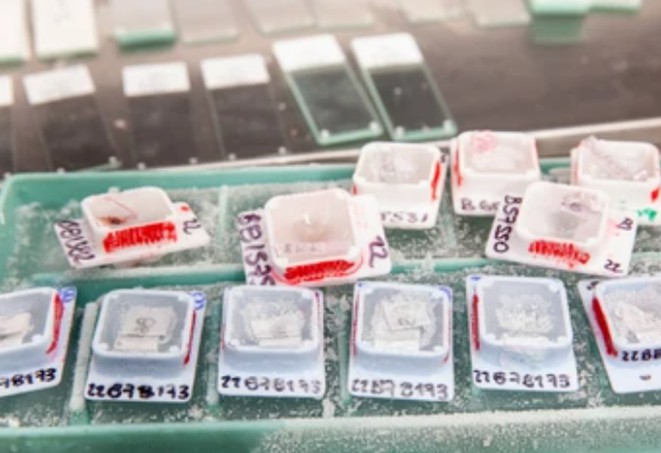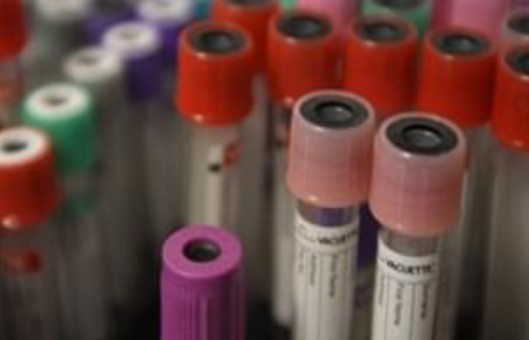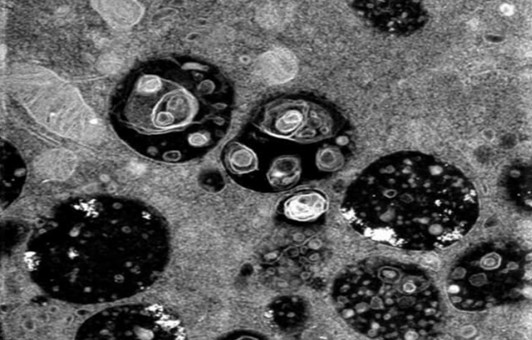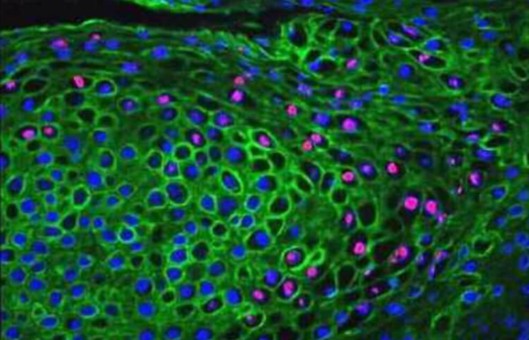Frozen Tissue Sectioning Protocol
GUIDELINE
Frozen tissue sectioning is the use of freezing to harden the tissue in a relatively short period of time, which can be cut into very thin sections and applied to various examinations. While frozen sections are physically less stable than paraffin, they are especially superior in the preservation of antigenicity and lipid retention. It is the most widely used in histological techniques, especially for rapid intraoperative pathological diagnosis of clinical surgery patients and histochemical and immunohistochemical diagnostic studies in scientific research.
METHODS
- Fresh material should be taken as quickly as possible to prevent post-mortem changes in the tissue.
- Place the tissue block flat in a soft plastic bottle cap or special box (about 2 cm in diameter). If the tissue block is small, add OCT embedding agent in appropriate amount to submerge the tissue, and put the special cassette into the cup with liquid nitrogen slowly and flatly. When the bottom of the box is in contact with the liquid nitrogen, it starts to boil, at this time the box remains in place, do not dip into the liquid nitrogen, about 10-20 s tissue is rapidly frozen into a block.

- The sample tray is coated with a layer of OCT embedding gel, and the quick-frozen tissue is placed on it, and the 4°C refrigerator was pre-chilled for 5-10 min to let the OCT gel soak through the tissue. Remove the tissue and place it on a tin foil or slide, and snap freeze the sample tray. The tissue is placed on the sample tray with another layer of OCT adhesive on it to completely cover the tissue, and snap frozen on the rack (PE) for 30 min.
- The basic structure is that the slicer is placed in a low-temperature sealed room, so the slicing is not affected by the external temperature and environment, and can be continuously sliced to 5-10μm. When slicing, the temperature in the low-temperature room is -15°C to -20°C is appropriate, the temperature is too low and the tissue is easy to break, the position and angle of the anti-roll plate should be appropriate, and the slide should be attached to the tissue section, do not move up and down.
- After cut and placed at room temperature for 30 min, fixed in acetone at 4°C for 5-10 min and oven dried for 20 min. 5 min x 3 for PBS wash.
NOTES
- After the block is frozen, it can be placed in a constant-cooling chamber for freezing and slicing. If it needs to be stored, it should be quickly sealed with aluminum foil or plastic film and immediately placed in -80°C refrigerator for storage.
- The key to making frozen tissue sections lies in the adjustment of the anti-collapse plate, which requires the operator to be careful and accurately adjust it to the proper position.
- When the cut tissue is adhered to a clean slide, a slight force in one direction can avoid folding of the tissue during the spreading process and ensure the integrity of the tissue structure and the beauty of the slice.
RELATED PRODUCTS & SERVICES
For research use only. Not for any other purpose.
Resources
- FAQ
- Protocol
- Cell Culture Guide
- Technical Bulletins
-
Explore & Learn
-
Cell Biology
- How to Handle Mycoplasma in Cell Culture?
- Strategies for Enrichment of Circulating Tumor Cells (CTCs)
- Enrichment, Isolation and Characterization of Circulating Tumor Cells (CTCs)
- How to Assess the Migratory and Invasive Capacity of Cells?
- Tips For Cell Cryopreservation
- T Cell Activation and Expansion
- What Cell Lines Are Commonly Used in Biopharmaceutical Production?
- Comparison of Several Techniques for the Detection of Apoptotic Cells
- STR Profiling—The ID Card of Cell Line
- What are the Differences Between M1 and M2 Macrophages?
- Mesenchymal Stem Cells: A Comprehensive Exploration
- Quantification of Cytokines
- Organoid Differentiation from Induced Pluripotent Stem Cells
- Multi-Differentiation of Peripheral Blood Mononuclear Cells
- Biomarkers and Signaling Pathways in Tumor Stem Cells
- IL-12 Family Cytokines and Their Immune Functions
- What are Mesothelial Cells?
- How to Scale Up Single-Cell Clones?
- Techniques for Cell Separation
- Contamination of Cell Cultures & Treatment
- Cell Culture Medium
- What Are Myeloid Cell Markers?
- Cryopreservation of Cells Step by Step
- Cell Cryopreservation Techniques and Practices
- Human Primary Cells: Definition, Assay, Applications
- How to Eliminate Mycoplasma From Cell Cultures?
- T Cell, NK Cell Differentiation from Induced Pluripotent Stem Cells
- Critical Quality Attributes and Assays for Induced Pluripotent Stem Cells
- What Is Cell Proliferation and How to Analyze It?
- Direct vs. Indirect Cell-Based ELISA
- Major Problems Caused by the Use of Uncharacterized Cell Lines
- Unveiling the Molecular Secrets of Adipogenesis in MSCs
- Tumor Stem Cells: Identification, Isolation and Therapeutic Interventions
- How to Decide Between 2D and 3D Cell Cultures?
- Isolation, Expansion, and Analysis of Natural Killer Cells
- Neural Differentiation from Induced Pluripotent Stem Cells
- Guidelines for Cell Banking to Ensure the Safety of Biologics
- Circulating Tumor Cells as Cancer Biomarkers in the Clinic
- CFU Assay for Hematopoietic Cell
- How to Start Your Culture: Thawing Frozen Cells
- Monocytes vs. Macrophages
- How to Detect and Remove Endotoxins in Biologics?
- Comparison of Different Methods to Measure Cell Viability
- What are PBMCs?
- How to Isolate PBMCs from Whole Blood?
- Troubleshooting Cell Culture Contamination: A Comprehensive Guide
- CHO Cell Line Development
- Comparison of the MSCs from Different Sources
- How to Isolate and Analyze Tumor-Infiltrating Leukocytes?
- Generation and Applications of Neural Stem Cells
- Stem Cell Markers
- Spheroid vs. Organoid: Choosing the Right 3D Model for Your Research
- Cell-Based High-Throughput Screening Techniques
- Overview of Cell Apoptosis Assays
- Mastering Cell Culture and Cryopreservation: Key Strategies for Optimal Cell Viability and Stability
- Adherent and Suspension Cell Culture
- How to Maximize Efficiency in Cell-Based High-Throughput Screening?
- Understanding Immunogenicity Assays: A Comprehensive Guide
- What are White Blood Cells?
- What Are the Pros and Cons of Adoptive Cell Therapy?
- Role of Cell-Based Assays in Drug Discovery and Development
- Eosinophils vs. Basophils vs. Neutrophils
- Cultivated Meat: What to Know?
- Optimization Strategies of Cell-Based Assays
- 3D-Cell Model in Cell-Based Assay
- Immunogenicity Testing: ELISA and MSD Assays
- Optimization Strategies of Cell-Based Assays
- Immunogenicity Testing: ELISA and MSD Assays
- From Collection to Cure: How ACT Works in Cancer Immunotherapy
- Types of Cell Therapy for Cancer
- From Blur to Clarity: Solving Resolution Limits in Live Cell Imaging
- Live Cell Imaging: Unveiling the Dynamic World of Cellular Processes
- From Blur to Clarity: Solving Resolution Limits in Live Cell Imaging
- 3D-Cell Model in Cell-Based Assay
- Exploring Cell Dynamics: Migration, Invasion, Adhesion, Angiogenesis, and EMT Assays
- Key Techniques in Primary, Immortalized and Stable Cell Line Development
- From Primary to Immortalized: Navigating Key Cell Lines in Biomedical Research
- A Complete Guide to Immortalized Cancer Cell Lines in Cancer Research
- Cell Viability, Proliferation and Cytotoxicity Assays
- What Are CAR T Cells?
- Cell Immortalization Step by Step
- Live Cell Imaging: Unveiling the Dynamic World of Cellular Processes
-
Histology
- Troubleshooting in Fluorescent Staining
- Fluorescent Nuclear Staining Dyes
- Tips for Choosing the Right Protease Inhibitor
- Multiple Animal Tissue Arrays
- Instructions for Tumour Tissue Collection, Storage and Dissociation
- Guides for Live Cell Imaging Dyes
- Cell Lysates: Composition, Properties, and Preparation
- Overview of the FFPE Cell Pellet Product Lines
- Immunohistochemistry Troubleshooting
- Cell and Tissue Fixation
- Microscope Platforms
- How to Apply NGS Technologies to FFPE Tissues?
- Overview of Common Tracking Labels for MSCs
- Mitochondrial Staining
- Immunohistochemistry Controls
- Comparison of Membrane Stains vs. Cell Surface Stains
- Stains Used in Histology
- How to Choose the Right Antibody for Immunohistochemistry (IHC)
- How to Begin with Multiplex Immunohistochemistry (mIHC)
- How Immunohistochemistry Makes the Invisible Brain Visible?
- Histological Staining Techniques: From Traditional Chemical Staining to Immunohistochemistry
- Common Immunohistochemistry Stains and Their Role in Cancer Diagnosis
- Serum vs. Plasma
- Comparing IHC, ICC, and IF: Which One Fits Your Research?
- Multiplexing Immunohistochemistry
- What You Must Know About Neuroscience IHC?
- From Specimen to Slide: Core Methods in Histological Practice
- Modern Histological Techniques
-
Exosome
- What's the Potential of PELN in Disease Treatment?
- How to Enhancement Exosome Production?
- How to characterize exosomes?
- How to Efficiently Utilize MSC Exosomes for Disease Treatment?
- How to Apply Exosomes in Clinical?
- Exosomes as Emerging Biomarker Tools for Diseases
- How to Label Exosomes?
- Emerging Technologies and Methodologies for Exosome Research
- Classification, Isolation Techniques and Characterization of Exosomes
- How to Perform Targeted Modification of Exosomes?
- Summary of Approaches for Loading Cargo into Exosomes
- How do PELN Deliver Drugs?
- Current Research Status of Milk Exosomes
- Exosome Quality Control: How to Do It?
- The Role of Exosomes in Cancer
- Techniques for Exosome Quantification
- What are the Functions of Exosomal Proteins?
- Exosome Size Measurement
- Applications of MSC-EVs in Immune Regulation and Regeneration
- Production of Exosomes: Human Cell Lines and Cultivation Modes
- Unraveling Biogenesis and Composition of Exosomes
- Common Techniques for Exosome Nucleic Acid Extraction
- Exosome Transfection for Altering Biomolecular Delivery
- How Important are Lipids in Exosome Composition and Biogenesis?
- Exosome Antibodies
- Collection of Exosome Samples and Precautions
-
ISH/FISH
- ISH probe labeling method
- Reagents Used in FISH Experiments
- What Types of Multicolor FISH Probe Sets Are Available?
- Mapping of Transgenes by FISH
- Small RNA Detection by ISH Methods
- What Is the Use of FISH in Solid Tumors?
- Multiple Options for Proving Monoclonality
- FISH Techniques for Biofilm Detection
- Whole Chromosome Painting Probes for FISH
- Comprehensive Comparison of IHC, CISH, and FISH Techniques
- What are the Differences between FISH, aCGH, and NGS?
- Overview of Oligo-FISH Technology
- Differences Between DNA and RNA Probes
- FISH Tips and Troubleshooting
- Telomere Length Measurement Methods
- Comparative Genomic Hybridization and Its Applications
- In Situ Hybridization Probes
- Guidelines for the Design of FISH Probes
- Different Types of FISH Probes for Oncology Research
- How to Use FISH in Hematologic Neoplasms?
- What are Single, Dual, and Multiplex ISH?
- Multiple Approaches to Karyotyping
- Overview of Common FISH Techniques
- CARD-FISH: Illuminating Microbial Diversity
- RNAscope ISH Technology
- ImmunoFISH: Integrates FISH and IL for Dual Detection
- 9 ISH Tips You Can't Ignore
-
Toxicokinetics & Pharmacokinetics
- Experimental Methods for Identifying Drug-Drug Interactions
- Key Considerations in Toxicokinetic
- Organ-on-a-Chip Systems for Drug Screening
- Overview of In Vitro Permeability Assays
- Traditional vs. Novel Drug Delivery Methods
- Pharmacokinetics Considerations for Antibody Drug Conjugates
- How to Improve Drug Plasma Stability?
- What Are Metabolism-Mediated Drug-Drug Interactions?
- Methods of Parallel Artificial Membrane Permeability Assays
- The Rise of In Vitro Testing in Drug Development
- How to Conduct a Bioavailability Assessment?
- Predictive Modeling of Metabolic Drug Toxicity
- What Are Compartment Models in Pharmacokinetics?
- Comparison of MDCK-MDR1 and Caco-2 Cell-Based Permeability Assays
- Unraveling the Role of hERG Channels in Drug Safety
- What factors influence drug distribution?
- How to Design and Synthesize Antibody Drug Conjugates?
- Physical and Chemical Properties of Drugs and Calculations
- Key Factors Influencing Brain Distribution of Drugs
- What Is the Role of the Blood-Brain Barrier in Drug Delivery?
- Parameters of Pharmacokinetics: Absorption, Distribution, Metabolism, Excretion
- What are the Pharmacokinetic Properties of the Antisense Oligonucleotides?
- How to Improve Drug Distribution in the Brain
- Effects of Cytochrome P450 Metabolism on Drug Interactions
- Toxicokinetics vs. Pharmacokinetics
- Pharmacokinetics of Therapeutic Peptides
- Organoids in Drug Discovery: Revolutionizing Therapeutic Research
- How Is the Cytotoxicity of Drugs Determined?
- How to Improve the Pharmacokinetic Properties of Peptides?
- From Cells to Systems: Modern Approaches to Disease Modeling
- How Genotoxicity Testing Guides Safer Drug Development
- What Is Genotoxicity in Pharmacology? Mechanisms and Sources
- What Are the Best Methods to Test Cardiotoxicity?
- Why Cardiotoxicity Matters in R&D?
-
Disease Models
- What Human Disease Models Are Available for Drug Development?
- Overview of Cardiovascular Disease Models in Drug Discovery
- Summary of Advantages and Limitations of Different Oncology Animal Models
- Why Use PDX Models for Cancer Research?
- Disease Models of Diabetes Mellitus
- Animal Models of Neurodegenerative Diseases
- Preclinical Models of Acute Liver Failure
-
Cell Biology
- Life Science Articles
- Download Center
- Trending Newsletter


